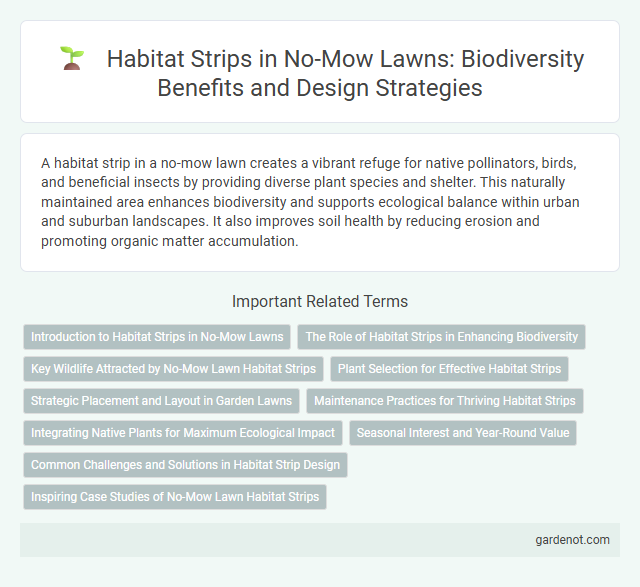A habitat strip in a no-mow lawn creates a vibrant refuge for native pollinators, birds, and beneficial insects by providing diverse plant species and shelter. This naturally maintained area enhances biodiversity and supports ecological balance within urban and suburban landscapes. It also improves soil health by reducing erosion and promoting organic matter accumulation.
Introduction to Habitat Strips in No-Mow Lawns
Habitat strips in no-mow lawns create essential biodiversity zones that support pollinators, birds, and beneficial insects by providing native plants and natural shelter. These strips improve soil health, reduce erosion, and require less water and maintenance compared to traditional lawns, promoting sustainable landscaping. Integrating habitat strips enhances ecological balance while conserving resources in urban and suburban environments.
The Role of Habitat Strips in Enhancing Biodiversity
Habitat strips in no-mow lawns create essential microhabitats that support pollinators, birds, and beneficial insects, significantly enhancing local biodiversity. These strips serve as ecological corridors that connect fragmented green spaces, enabling wildlife movement and genetic exchange. They also improve soil health and water retention, contributing to a more resilient urban ecosystem.
Key Wildlife Attracted by No-Mow Lawn Habitat Strips
No-mow lawn habitat strips provide essential refuge and nesting sites for pollinators like bees, butterflies, and native wildflowers, fostering biodiversity in urban and suburban areas. These strips support ground-nesting birds such as sparrows and bluebirds by offering undisturbed cover and ample food sources from seeds and insects. Small mammals like chipmunks and beneficial insects also thrive within no-mow habitat zones, contributing to ecosystem balance and natural pest control.
Plant Selection for Effective Habitat Strips
Choosing native wildflowers, grasses, and shrubs cultivates a thriving habitat strip that supports local pollinators and wildlife. Selecting drought-tolerant, low-maintenance species such as echinacea, milkweed, and little bluestem ensures sustainability and minimal water use. Incorporating diverse plant heights and bloom times extends seasonal resources and enhances ecological benefits in no-mow lawn designs.
Strategic Placement and Layout in Garden Lawns
Strategic placement of habitat strips in garden lawns enhances biodiversity by providing essential resources for pollinators, birds, and beneficial insects. Designing these strips with varied native plant species and layering them along garden edges or pathways maximizes ecological benefits and aesthetic appeal. Proper layout ensures minimal disruption to no-mow zones while promoting natural pest control and habitat connectivity within urban green spaces.
Maintenance Practices for Thriving Habitat Strips
Habitat strips thrive through minimal mowing, allowing native plants to establish deep root systems that support local wildlife and improve soil health. Targeted mowing once or twice annually prevents invasive species while preserving essential flowering plants for pollinators. Implementing seasonal mowing schedules maximizes biodiversity and maintains the ecological balance within no-mow lawn habitat strips.
Integrating Native Plants for Maximum Ecological Impact
Habitat strips designed with native plants enhance biodiversity by providing essential food and shelter for local wildlife, supporting pollinators, birds, and beneficial insects. Incorporating deep-rooted native species improves soil health, reduces erosion, and promotes water retention, creating a resilient ecosystem within no-mow lawns. Strategic placement of diverse native plant varieties maximizes ecological impact by fostering interconnected habitats and sustaining natural lifecycle processes.
Seasonal Interest and Year-Round Value
A habitat strip within a no-mow lawn enhances seasonal interest by supporting diverse native plants that bloom at different times of the year, attracting pollinators and wildlife. This strip provides year-round value through its ability to improve soil health, reduce erosion, and create a resilient ecosystem that thrives without frequent mowing. Integrating habitat strips promotes biodiversity while requiring minimal maintenance, making them a sustainable feature for eco-friendly landscapes.
Common Challenges and Solutions in Habitat Strip Design
Habitat strips often face challenges such as soil compaction, invasive species intrusion, and poor plant diversity, which can hinder ecosystem functionality. Implementing strategic planting of native species with deep root systems improves soil health and biodiversity, while regular maintenance controls invasive plants. Designing variable microhabitats within the strip encourages wildlife habitation and resilience against environmental stressors.
Inspiring Case Studies of No-Mow Lawn Habitat Strips
Habitat strips in no-mow lawns provide essential refuge for pollinators, birds, and beneficial insects by incorporating native wildflowers and grasses. Studies from urban gardens and suburban parks reveal increased biodiversity and improved soil health within these low-maintenance zones. Successful cases highlight the synergy between ecological benefits and aesthetic appeal in creating sustainable green spaces.
Habitat strip Infographic

 gardenot.com
gardenot.com